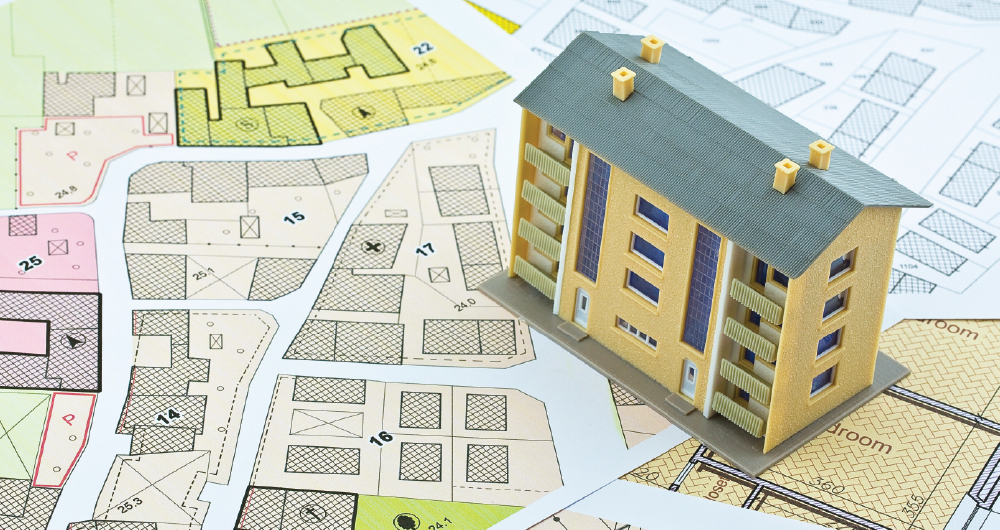Zoning 101: Exclusionary zoning as a barrier to housing production
Celebrating NAHREP familia, cultura, politics, and grassroots action
October, 2022

The first comprehensive city zoning ordinance was created in New York City in 1916, in response to a 42-story building built in a Manhattan neighborhood that cast a seven acre shadow, leaving many of its neighbors in the dark. At the same time, New York and other cities across the country were grappling with industrial warehouses and factories cropping up near residential neighborhoods. What started as a public health measure, to protect citizens from pollutants and toxins emitted from industrial sites, quickly turned into a tool to segregate neighborhoods.
Zoning? ¿Qué es eso?
Zoning is a set of regulations that city governments use to separate land and determine what types of structures can be built (commercial, residential, manufacturing, etc.), including height limits, and parking requirements in certain areas. Zoning can also determine what signage is allowed in the area and how many residents can live there. For example, early zoning regulations aimed to protect public health in residential neighborhoods by separating them from oil drilling sites, slaughterhouses or other areas with potential fire hazards. Some zoning laws, however, have also been used to exclude people of color from living in certain neighborhoods.
So, what’s the problem?
In addition to protecting public health, many communities used zoning laws to racially segregate neighborhoods. Historically, redlining and racially restrictive covenants in zoning laws prohibited communities of color from obtaining mortgages and owning, renting, or occupying property in certain neighborhoods. While these practices are no longer legally allowed, more subtle forms of discrimination in zoning continue to take place. When people of color are not allowed to live in more affluent neighborhoods, or if the neighborhoods they live in are deemed less valuable, this setbacks wealth creation for these families.
Moreover, restrictive zoning laws limit lower-cost housing developments in specific neighborhoods. For example, in single-family zoning, one housing unit can be built in one lot (or parcel) of land, creating significant barriers to building multi-family housing. It is estimated that up to 75% of residential neighborhoods in the U.S. are zoned for single-family housing only. In cities, height limits for new buildings restrict density and affordable housing development. Restrictive and exclusionary zoning limits housing supply in neighborhoods, contributing to the housing shortage and excluding lower-income residents from accessing housing opportunities.
One of the most pressing barriers to advancing our mission is the lack of housing inventory available for purchase, particularly at the entry-level. A decade-long shortfall in the annual production of new housing has left the nation with far fewer housing units than are needed. Some estimate the gap has exceeded 5 million units. While a housing shortage exists in nearly every market across the country, it is even more pronounced in Latino communities. Nine of the top ten markets exhibiting the highest rate of housing underproduction have a Latino population above the national average, while seven out of ten have a Latino population above 40 percent. Addressing exclusionary and restrictive zoning will be a major contributor to solving the housing inventory crisis.
What can we do about it?
According to the Congressional Hispanic Caucus Institute, two ways to change zoning to improve low-income Latino homeownership is by getting rid of single-family zoning laws and by establishing zoning laws that incentivize higher-density housing. Duplexes and triplexes are ultimately more affordable, and smaller homes cost less in maintenance and utilities.
NAHREP’s policy priorities provide a roadmap for how states and localities can reduce exclusionary zoning, including:
- Zoning reform to allow for more density, including the building of condos and townhomes.
- Rezone commercially zoned properties or repurpose unused buildings for housing and mix-use.
- End apartment/condo bans within one-quarter mile of job centers and existing transit stops.
- Incentivize building housing near existing job centers and public transportation.
- Streamline and lower barriers for housing developments and permit approvals.
- Allow homeowners to convert an existing single-family structure into a duplex, triplex, or fourplex.
- Permit small lot subdivisions to encourage the development of detached townhomes that do not require being part of a homeowners’ association.
- Provide tax breaks for new home construction and avoid subjecting housing approvals to discretionary processes.
- Legalize accessory dwelling units, finished basements, efficiencies, or in-law suites in existing lots.
- Create transparency around institutional investors purchasing single-family homes.
- Create a funding mechanism or grant for small developers to build homes.
- Ensure that housing developments planned for cities and municipalities also include homeownership housing.
We urge you to get involved in the zoning debate in your communities. Revisit part one and part two of our blogs about speaking up at city council meetings for more information on how you can make a difference.
About NAHREP’s National Advocacy Committee
The National Association of Hispanic Real Estate Professionals® (NAHREP®) advocates on behalf of its network of 50,000 real estate professionals and Hispanic homeowners nationwide. NAHREP focuses on national and state legislative issues that are critical to its mission: to advance sustainable Hispanic homeownership.
NAHREP firmly believes every individual who desires to become a homeowner and can sustain a mortgage should be granted access to a piece of the American Dream. To that end, we are focused on three main priorities: Housing Inventory, Access to Credit, and Immigration. Visit our website to read more about NAHREP’s policy priorities and to get involved.


